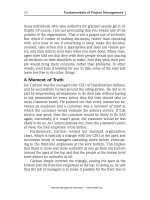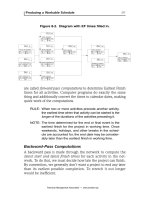Exploring management 6th by schermerhornch16
Bạn đang xem bản rút gọn của tài liệu. Xem và tải ngay bản đầy đủ của tài liệu tại đây (567.02 KB, 30 trang )
Exploring
Management
John R. Schermerhorn Jr. and Daniel G. Bachrach
Sixth Edition
Chapter 16
Diversity and Global Cultures
A day at work, a trip to the
store, a visit with friends—all
bring diversity into our lives.
Even a walk across the
college campus can be a trip
around the world, if you’re
willing to take it.
Copyright ©2018 John Wiley & Sons, Inc.
2
Your Chapter 16 Takeaways
• Understand what we need to know about
diversity in the workplace (16.1)
• Understand what we need to know about
diversity among global cultures (16.2)
Copyright ©2018 John Wiley & Sons, Inc.
3
DIVERSITY IN THE WORKPLACE 16.1
Takeaway 16.1 – answers to come
• Inclusion drives the business case for diversity.
• Multicultural organizations cultures value and
support diversity.
• Diversity bias exists in many situations
• Organizational subcultures create diversity
challenges.
• Managing diversity is a leadership priority.
Copyright ©2018 John Wiley & Sons, Inc.
4
DIVERSITY IN THE WORKPLACE 16.1
Business Case for Diversity
• Diversity
• Describes attributes such as national origin,
age, race, gender, sexual orientation, and
other individual differences
• Surface-level diversity
• consists of more visible attributes such as age,
race, gender, and ethnicity.
• Deep-level diversity
• consists of psychological attributes such as
personality and values.
Copyright ©2018 John Wiley & Sons, Inc.
5
DIVERSITY IN THE WORKPLACE 16.1
Business Case for Diversity
• Revolving door syndrome
• High employee turnover among minorities
and women.
• Inclusion
• Degree to which an organization is open to
anyone who can perform a job regardless of
race, gender, age or any other individual
difference
Copyright ©2018 John Wiley & Sons, Inc.
6
DIVERSITY IN THE WORKPLACE 16.1
Business Case for Diversity
“To be successful in working with and gaining value
from diversity requires a sustained, systemic
approach and long-term commitment. Success is
facilitated by a perspective that considers diversity
to be an opportunity for everyone in an
organization to learn from each other how better
to accomplish their work and an occasion that
requires a supportive and cooperative
organizational culture as well as group leadership
and process skills that can facilitate effective group
functioning.”
Copyright ©2018 John Wiley & Sons, Inc.
7
DIVERSITY IN THE WORKPLACE 16.1
Multicultural Organizations
• Multicultural organizations value and support diversity
• Based on pluralism and operates with inclusivity
and respect for diversity
Copyright ©2018 John Wiley & Sons, Inc.
8
DIVERSITY IN THE WORKPLACE 16.1
Diversity Bias
• The word “diversity” means the presence of
“differences,” and differences are potentially
challenging in most circumstances.
• Leaking pipeline shows up in male-dominated
organizations.
• It occurs as women drop out of upward career
tracks because of glass ceilings and other obstacles.
• Implicit bias
• shows up as prejudice that is largely unconscious
and unrecognized but that still results in
discriminatoryCopyright
treatment
of others.
©2018 John Wiley & Sons, Inc.
9
DIVERSITY IN THE WORKPLACE 16.1
Business and Diversity
Glass Ceiling
• Career advancement barrier to women and minorities
FIGURE 16.1 How Do Glass Ceilings Constrain Career
Advancement for Women and Minorities?
Copyright ©2018 John Wiley & Sons, Inc.
10
DIVERSITY IN THE WORKPLACE 16.1
Business and Diversity
• Biculturalism
• Minority members adopt characteristics of
majority cultures in order to succeed.
• The Glass Closet
• when lesbians, gays, bisexuals, and
transgender workers hide their sexual
orientation and gender identity.
Copyright ©2018 John Wiley & Sons, Inc.
11
DIVERSITY IN THE WORKPLACE 16.1
Organizational Subcultures
• Organizational subcultures
• Groupings of people based on shared demographic
and job identities
• Occupations
• Race and Ethnicity
• Religion
• Gender
• Generational
• Ethnocentrism
• Belief that one’s membership group or subculture
is superior to all others
• Occupational subcultures
• Formed among people doing same kinds of work
Copyright ©2018 John Wiley & Sons, Inc.
12
DIVERSITY IN THE WORKPLACE 16.1
Managing Diversity
• Affirmative action
• Management commitment to hiring and advancing women
and minorities
• Valuing differences
• Education and training to understand and respect
differences.
• Managing diversity
• Building an inclusive network that allows everyone to reach
his or her potential
Copyright ©2018 John Wiley & Sons, Inc.
13
DIVERSITY IN THE WORKPLACE 16.1
Study Guide for Takeaway 16.1
Rapid Review:
• Workforce diversity can improve business performance by expanding
the talent pool of the organization and establishing better
understandings of customers and stakeholders.
• Inclusivity is a characteristic of multicultural organizations that values
and respects diversity of their members.
• Minorities and women can suffer diversity bias in such forms as job
and pay discrimination, sexual harassment, and the glass ceiling effect.
• Organizational subcultures, including those based on occupational,
functional, ethnicity, nationality, age, and gender differences, can
create diversity challenges.
• A top leadership priority should be managing diversity to develop an
inclusive work environment within which everyone is able to reach
their full potential.
Copyright ©2018 John Wiley & Sons, Inc.
14
DIVERSITY IN THE WORKPLACE 16.1
Study Guide for Takeaway 16.1
Questions for Discussion:
1. What subcultures do you see operating at work
and/or in school, and how do they affect
relationships and daily events?
2. What are some of the things organizations and
leaders can do to reduce diversity bias faced by
minorities and women in the workplace?
3. What does the existence of an affirmative
action policy say about an organization’s
commitment to diversity?
Copyright ©2018 John Wiley & Sons, Inc.
15
DIVERSITY IN THE WORKPLACE 16.1
Be Sure You Can…for Takeaway 16.1
• identify major diversity trends in American
society.
• explain the business case for diversity.
• explain the concept of inclusivity.
• list characteristics of multicultural organizations.
• identify subcultures common to organizations.
• discuss the types of employment problems faced
by minorities and women.
• explain Thomas’s concept of managing diversity.
Copyright ©2018 John Wiley & Sons, Inc.
16
GLOBAL CULTURES 16.2
Takeaway 16.2 – answers to come
• Culture shock comes from discomfort in cross-cultural
situations.
• Cultural intelligence is the capacity to adapt to foreign
cultures.
• The “silent” languages of cultures include context, time,
and space.
• Cultural tightness and looseness varies around the world.
• Hofstede’s model identifies five value differences among
national cultures.
• Intercultural competencies are essential career skills.
Copyright ©2018 John Wiley & Sons, Inc.
17
GLOBAL CULTURES 16.2
Culture Shock
Culture shock comes from discomfort in cross-cultural situations
• Stages include:
• Confusion—First contacts with the new culture leave you anxious,
uncomfortable, and in need of information and advice.
• Small victories—Continued interactions bring some “successes,”
and your confidence grows in handling daily aff airs.
• Honeymoon—A time of wonderment, cultural immersion, and
even infatuation with local ways viewed positively.
• Irritation and anger—A time when the “negatives” overwhelm the
“positives,” and the new culture becomes a target of your
criticism.
• Reality—A time of rebalancing;
you are able to enjoy the new
Copyright ©2018 John Wiley & Sons, Inc.
18
GLOBAL CULTURES 16.2
Cultural Intelligence
• Cultural intelligence (CQ) is the ability to adapt
to new cultures and work well in situations of
cultural diversity.
• People with high CQ have high cultural
awareness and are flexible in dealing with
cultural differences.
• They are willing to learn from unfamiliar
situations and modify their behaviors to act
with sensitivity toward another culture’s ways.
Copyright ©2018 John Wiley & Sons, Inc.
19
GLOBAL CULTURES 16.2
The “Silent” Languages of Cultures
• High-context
• Rely on unspoken or situational cues as well as
spoken or
written words in communication
• Low-context
• Emphasize communication via spoken or written
words
Copyright ©2018 John Wiley & Sons, Inc.
20
GLOBAL CULTURES 16.2
Time as a Silent Language of Culture
• Monochronic
• People tend to do one thing at a time
• Typical of the United States, where meetings
are scheduled for an individual or group to
focus on a single issue for an allotted time
period.
• Polychronic
• People accomplish many different things at
once, though in no particular order
• More flexible about time and who uses it
Copyright ©2018 John Wiley & Sons, Inc.
21
GLOBAL CULTURES 16.2
Space as a Silent Language of Culture
• Proxemics
• The study of how people use and value space.
• The ways space communicates varies across
cultures.
• How people use interpersonal space to
communicate
• Space is precious in Japan, so it is
respected and carefully planned.
• Americans, by contrast, tend to like as
much space as they can get.
Copyright ©2018 John Wiley & Sons, Inc.
22
GLOBAL CULTURES 16.2
Tight and Loose Cultures
• Tight Cultures
• The goal in tight cultures, as suggested in the
Asian proverb, is to fit in with society’s
expectations and not stand out.
• Loose Cultures
• Social norms are mixed and less clear cut
• Conformity will vary a good deal
• Deviations from norms tend to be tolerated
Copyright ©2018 John Wiley & Sons, Inc.
23
GLOBAL CULTURES 16.2
Hofstede’s Model and Value Differences
FIGURE 16.2 How Do Countries Compare on
Hofstede’s Five Dimensions of National Cultures?
Copyright ©2018 John Wiley & Sons, Inc.
24
GLOBAL CULTURES 16.2
Dimensions of National Cultures
• Power Distance
• the degree to which a society accepts unequal distribution
of power
• Uncertainty Avoidance
• the degree to which a society tolerates risk and uncertainty.
• Individualism-collectivism
• the degree to which a society emphasizes individuals
and their self-interests
• Masculinity-femininity
• the degree a society values assertiveness and materialism
versus feelings, relationships, and quality of life.
• Time orientation
• the degree to which a society emphasizes short-term
or long-term goals
Copyright ©2018 John Wiley & Sons, Inc.
25









